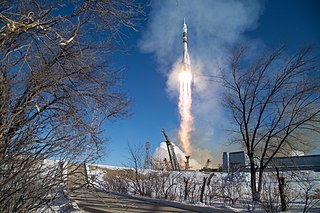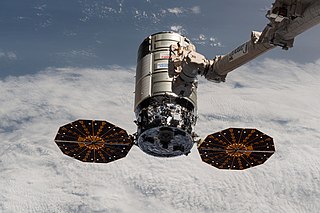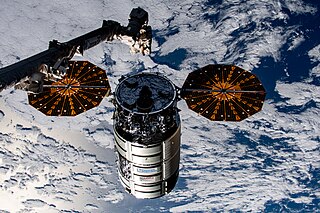
Space manufacturing is the production of tangible goods beyond Earth. Since most production capabilities are limited to low Earth orbit, the term in-orbit manufacturing is also frequently used.

The International Space Station is a platform for scientific research that requires one or more of the unusual conditions present in low Earth orbit. The primary fields of research include human research, space medicine, life sciences, physical sciences, astronomy and meteorology. The 2005 NASA Authorization Act designated the American segment of the International Space Station as a national laboratory with the goal of increasing the use of the ISS by other federal agencies and the private sector.

Kounotori 3, also known as HTV-3, was the third flight of the Japanese H-II Transfer Vehicle. It was launched on 21 July 2012 to resupply the International Space Station (ISS) aboard the H-IIB Launch Vehicle No. 3 manufactured by Mitsubishi Heavy Industries (MHI) and JAXA. Kounotori 3 arrived at the ISS on 27 July 2012, and Expedition 32 Flight Engineer and JAXA astronaut Akihiko Hoshide used the International Space Station's Canadarm2 robotic arm to install Kounotori 3, to its docking port on the Earth-facing side (nadir) of the Harmony module at 14:34 UTC.

SpaceX CRS-4, also known as SpX-4, was a Commercial Resupply Service mission to the International Space Station (ISS), contracted to NASA, which was launched on 21 September 2014 and arrived at the space station on 23 September 2014. It was the sixth flight for SpaceX's uncrewed Dragon cargo spacecraft, and the fourth SpaceX operational mission contracted to NASA under a Commercial Resupply Services contract. The mission brought equipment and supplies to the space station, including the first 3D printer to be tested in space, a device to measure wind speed on Earth, and small satellites to be launched from the station. It also brought 20 mice for long-term research aboard the ISS.

Orbital-3, also known as Orb-3, was an attempted flight of Cygnus, an automated cargo spacecraft developed by United States-based company Orbital Sciences, on 28 October 2014. The mission was intended to launch at 22:22:38 UTC that evening. This flight, which would have been its fourth to the International Space Station and the fifth of an Antares launch vehicle, resulted in the Antares rocket exploding seconds after liftoff.
Sciaky, Inc. is an American manufacturer of metal 3d printing systems and industrial welding systems, founded in 1939 and headquartered in Chicago, Illinois. It specializes in electron beam welding systems and services for aerospace manufacturers.

Soyuz MS-07 was a Soyuz spaceflight launched on 17 December 2017 at 07:21 UTC. It transported three members of the Expedition 54 crew to the International Space Station. Soyuz MS-07 was the 136th flight of a Soyuz spacecraft. The crew consisted of a Russian commander, Japanese doctor, and an American flight engineer.

SpaceX CRS-20 (CRS-20), also known as SpaceX-20, was a Commercial Resupply Service mission to the International Space Station (ISS) launched on 7 March 2020. The mission was contracted by NASA and was flown by SpaceX using Dragon. This was SpaceX's last flight for Dragon 1 and concluded the NASA Commercial Resupply Services (CRS-1) contract extension.
On-Orbit Servicing, Assembly, and Manufacturing 2 (OSAM-2), formally known as Archinaut, is a technology project developing the necessary additive manufacturing technology to build large-scale structures in space. The two-year project started in 2016 and was funded by a NASA contract worth US$20 million; it is being performed by a partnership of Made In Space (MIS), Northrop Grumman, and Oceaneering Space Systems. Its formal name is "Versatile In-Space Robotic Precision Manufacturing and Assembly System".

Julielynn Yee-Ching Wong is a physician, scientist and pilot, who is internationally recognized for using 3-D printing to deliver healthcare solutions to remote environments, including outer space. Wong is the founder and CEO of two organizations: 3D4MD and Medical Makers.
The ISS U.S. National Lab, commonly known as the ISS National Lab, is a U.S. government-funded national laboratory established on 30 December 2005 by the 2005 NASA Authorization Act. With principal research facilities located in the United States Orbital Segment (USOS) of the International Space Station (ISS), the Laboratory conducts research in life sciences, physical sciences, technology development and remote sensing for a broad range of academic, government and commercial users. Of the 270 payloads that the Center for the Advancement of Science in Space (CASIS) has sent to the ISS, 176 have been for commercial companies including Merck & Co., Novartis, Eli Lilly and Company, Hewlett Packard Enterprise, Honeywell, and Procter & Gamble.

SpaceX CRS-21, also known as SpX-21, was a Commercial Resupply Service mission to the International Space Station which launched on 6 December 2020. The mission was contracted by NASA and was flown by SpaceX using a Cargo Dragon 2. This was the first flight for SpaceX under NASA's CRS Phase 2 contract awarded in January 2016. This was also the first Cargo Dragon of the new Dragon 2 variant, as well as the first Cargo Dragon flight that was docked at the same time as a Crew Dragon spacecraft. This mission used Booster B1058.4, becoming the first NASA mission to reuse a booster previously used on a non-NASA mission. This was also first time SpaceX launched a NASA payload on a booster with more than one previous flight.

NG-14, previously known as OA-14, was the fifteenth flight of the Northrop Grumman robotic resupply spacecraft Cygnus and its fourteenth flight to the International Space Station under the Commercial Resupply Services (CRS-1) contract with NASA. The mission was launched on 3 October 2020, at 01:16:14 UTC.

NG-15, previously known as OA-15, was the fifteenth launch of the Northrop Grumman robotic resupply spacecraft Cygnus and its fourteenth flight to the International Space Station (ISS) under the Commercial Resupply Services (CRS) contract with NASA. The mission launched on 20 February 2021 at 17:36:50 UTC. This is the fourth launch of Cygnus under the CRS-2 contract.
Redwire Corporation is an American aerospace manufacturer and space infrastructure technology company headquartered in Jacksonville, Florida. The company was formed on June 1, 2020 by the private equity firm AE Industrial Partners.

NG-18 was the eighteenth flight of the Northrop Grumman robotic resupply spacecraft Cygnus and its seventeenth flight to the International Space Station (ISS) under the Commercial Resupply Services (CRS-2) contract with NASA. The mission successfully launched on 7 November 2022 at 10:32:42 UTC. This was the seventh launch of Cygnus under the CRS-2 contract.

NG-19 was the nineteenth flight of the Northrop Grumman robotic resupply spacecraft Cygnus and its eighteenth flight to the International Space Station (ISS) under the Commercial Resupply Services (CRS-2) contract with NASA. The mission launched on 2 August 2023 at 00:31:14 UTC. This was the eighth launch of Cygnus under the CRS-2 contract.

Microgravity bioprinting is the utilization of 3D bioprinting techniques under microgravity conditions to fabricate highly complex, functional tissue and organ structures. The zero gravity environment circumvents some of the current limitations of bioprinting on Earth including magnetic field disruption and biostructure retention during the printing process. Microgravity bioprinting is one of the initial steps to advancing in space exploration and colonization while furthering the possibilities of regenerative medicine.

SpaceX CRS-29, also known as SpX-29, is a Commercial Resupply Service mission to the International Space Station (ISS) launched on 10 November 2023. The mission is contracted by NASA and is scheduled to be flown by SpaceX using Cargo Dragon C211. This will the seventh flight for SpaceX under NASA's CRS Phase 2.

NG-20 is the twentieth flight of the Cygnus robotic resupply spacecraft and its seventeenth flight to the International Space Station (ISS). It launched on 30 January 2024. It is contracted to Northrop Grumman under the Commercial Resupply Services II (CRS-2) contract with NASA. The capsule launched aboard a SpaceX Falcon 9 rocket.
















